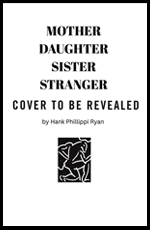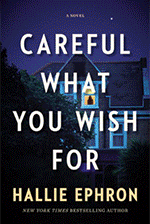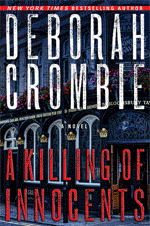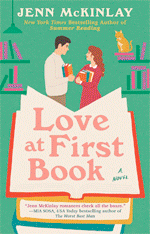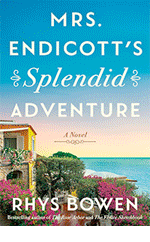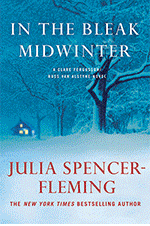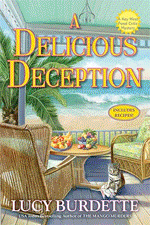HALLIE EPHRON: Earlier this week, I posted Susan Stamberg’s essay about getting hooked on books, and reading on her family’s “pink sofa,” a happy place where she devoured books. (Here's my sweet Jerry with our granddaughter, passing the torch on a pink-ish sofa.)
Reading about it got me remembering the place where, after dinner, my mother would read to me. The couch in our living room which was covered in a red, green, and white jungle print and was oh so cool and cozy when you buried your face in one of the cushions.
I wish I could say that there was some special place I would go alone to get lost in a book, but I wasn’t really that kind of reader. And I grew up in a house packed, floor-to-ceiling with books. But being read-TO was a special thing.
What are your earliest memories of books, where are you, and is there someone who’s your reading guide??
JENN McKINLAY: Mom read to us every night as littles and it was always the couch in the living room. Maurice Sendak, Patricia Coombs, Bill Peet, Dr. Seuss, and Judith Viorst were a few of our faves. When I started reading on my own–Hello, Nancy Drew!--it was in my bean bag chair in my room or outside under the dogwood tree in the backyard (parents were less likely to find me to do chores there).
HANK PHILLIPPI RYAN: Ah, well, I remember my father reading to me, actually, and I can still hear his voice reading MANY MOONS by James Thurber. And all the Poohs.
I kind of remember Mom and fairy tales, but I def remember how much I annoyed her, since at the end, she would say "and they lived happily ever after," and I would insist to know what REALLY happened. Like, after that. Happily ALL the time?
(Which, funnily, was the memory that inspired my upcoming book. Just saying. Thanks, Mom.)
And yes, when I could read on my own, I remember Cherry Ames and Trixie Belden, and Nancy D, and we read up in the hayloft of the barn. In the house, we had a huge blue curvy Eames chair, which was perfect. I wish I still had it.
RHYS BOWEN: I’m sad to say I don’t ever remember my mother reading to me. I was raised mainly by my grandmother and great aunt since my mother always worked ( as a teacher).
I know they read to me because when I was about three I had memorized quite a few books. I sit on a bus pretending to read, knowing exactly when to turn the pages and people would be amazed. Is she reading that? I suppose I was always a bit of a show off.
Like Hank I loved all of the Pooh stories and could recite all the poems. James James Morrison Morrison etc.
Later my grandmother would read to me. I remember Ballet Shoes. Black Beauty and the Secret Garden as favorites.
I read to myself in my bedroom up on the top floor of s big drafty house. First it was fantasy like The Faraway tree. Then the Famous Five.
My parents did not read. My mother was too busy and my father had no use for fiction. But I escaped to the library and found all sorts of wonderful things.
JULIA SPENCER-FLEMING: Moving around so much, I remember books, but not where I read them. I know my mother was passionate about reading-to, but I was an early reader, so my memories come from her sitting with my sister or my brother.
The first special reading place I can recall was one of the living room chairs in the house she bought in her mother’s home town. Happily, I inherited the mid-century beauty, and I still love sinking into its down-filled cushions.
Other than sitting in that chair, my favorite reading position was on my stomach - including, after bedtime, facing toward the hall light and undoubtedly straining my eyes, according to my grandmother.
Alas, you women who were “gifted” by the puberty fairy can understand why I had to give up reading this way around age 13.
My favorite reading chair now is an antique Stickley Morris Chair. Firm cushions, wide wooden arms perfect for holding a drink or a cup of tea - this chair is sixty years older than I am, but it’s definitely holding up better.
LUCY BURDETTE: So surprising Rhys that your parents didn’t read, considering what you’ve become! My mother loved to read, we often saw her with a magazine. I think with a job teaching kids and 4 of her own, shorter was better.
My dad often read to us–I still have my earliest hardback, The Scary Thing. I can’t tell you the author because it’s home in CT, but I can picture how I tried to write my name inside in crayon. My older sister and I usually retired to our bedroom to read after school. That’s still my favorite place to read (and write, which I know is bad for my body!)
DEBORAH CROMBIE: My grandmother was most definitely my reading guide. She'd been a teacher–now I wish I knew more about where and what she taught, but you don't think of those things as a child. We shared a room until I was about five and I think I have some vague memories of her reading to me in the double bed there. But then my parents built a separate suite for her and we read in the big, squashy armchair in her room.
Julia, we have two campaign chairs either side of a glass-topped chest in front of one of our living room windows, and I often will sit down with a book there.
HALLIE: Finishing up, I'd like to recommend a nonprofit that does a wonderful job supporting families who are raising readers. They do great work. RAISING A READER.
And please, share YOUR experiences with kids sharing with them the wonderful world of books.













